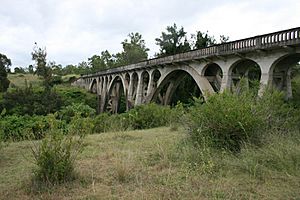Lockyer Creek Railway Bridge (Murphys Creek) facts for kids
Quick facts for kids Lockyer Creek Railway Bridge (Murphys Creek) |
|
|---|---|

Lockyer Creek Railway Bridge at Murphys Creek, 2009
|
|
| Location | Toowoomba - Helidon Line over Lockyer Creek at Murphys Creek, Lockyer Valley Region, Queensland, Australia |
| Design period | 1900 - 1914 (early 20th century) |
| Built | c. 1910 - 1911 |
| Architect | William Pagan |
| Official name: Lockyer Creek Railway Bridge (Guinn Park) | |
| Type | state heritage (built) |
| Designated | 21 October 1992 |
| Reference no. | 600515 |
| Significant period | 1910s (fabric) |
| Significant components | pier/s (bridge), abutments - railway bridge |
| Lua error in Module:Location_map at line 420: attempt to index field 'wikibase' (a nil value). | |
The Lockyer Creek Railway Bridge (Murphys Creek) is a special old railway bridge in Queensland, Australia. It crosses over Lockyer Creek near Murphys Creek. This bridge is part of the main railway line that connects Toowoomba and Helidon.
It was designed by a clever engineer named William Pagan. The bridge was built between 1910 and 1911. Today, it is listed on the Queensland Heritage Register. This means it is an important historical site that needs to be protected.
History of the Bridge
The railway line between Helidon and Toowoomba first opened way back on May 1, 1867. This line was very important for connecting Brisbane to Toowoomba. Over the years, people kept working to make the railway better. They wanted it to carry heavier trains and more goods.
Because of these upgrades, older bridges needed to be replaced. In 1909, work started on a new, strong concrete arch bridge over Lockyer Creek. This bridge was designed by William Pagan, who was the Chief Engineer at the time. His design was very new and clever for its time. The bridge was finished and opened for use on December 21, 1911.
What the Bridge Looks Like
The Lockyer Creek Railway Bridge is made of concrete and has several arches. It carries a single railway track. The track sits on a ballasted deck, which means it has a layer of crushed rock underneath.
Here are some of its main parts:
- It has two smaller concrete arches, each about 15 feet long.
- There is a large concrete arch that is 74 feet long. It supports three smaller arches on top.
- Another very large concrete arch is 90 feet long. This one supports four smaller arches above it.
- Then there's another 74-foot arch, supporting three smaller arches.
- Finally, there are three more 15-foot concrete arches.
The bridge has strong concrete supports called piers and abutments at its ends. Above the main arches, there are pairs of concrete columns. These columns help support the railway track. The whole bridge was built by pouring concrete into molds right there on the spot. It also has a concrete fence, called a balustrade, along its sides.
Why This Bridge is Special
The Lockyer Creek Railway Bridge was added to the Queensland Heritage Register in 1992. This means it's recognized as a very important part of Queensland's history and culture.
Here's why it's so special:
- It shows how Queensland grew: This bridge is a great example of how railway lines and engineering improved in Queensland over time. It helped connect important towns and move goods.
- It looks amazing: The bridge has a really cool and beautiful design. Its arches and structure make it stand out.
- It was a big achievement: When it was built, this bridge was very advanced. It has one of the largest concrete arches of its kind in Australia. This shows how clever the engineers were back then.
- It's linked to William Pagan: The bridge's smart and good-looking design is connected to its designer, William Pagan. He was a very important engineer in Queensland's history.

